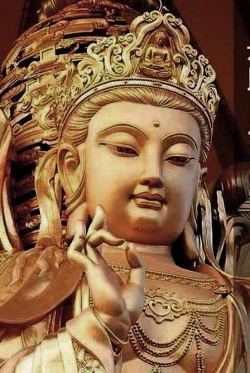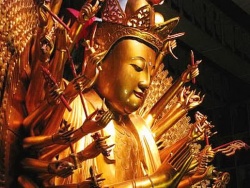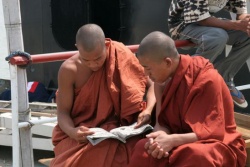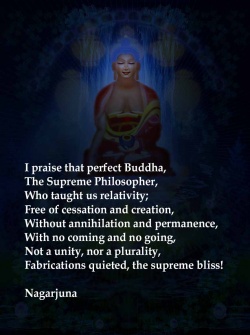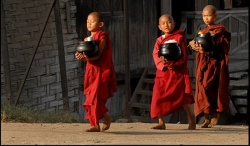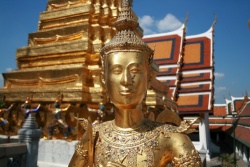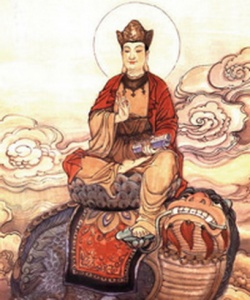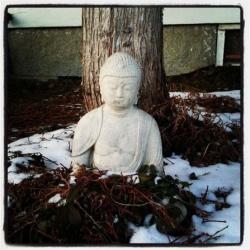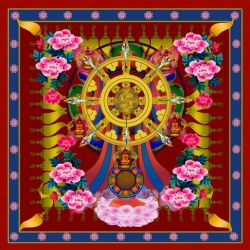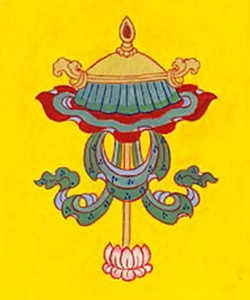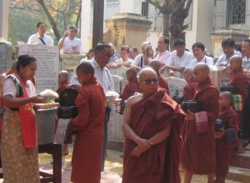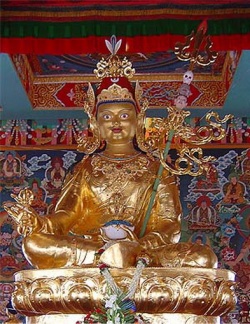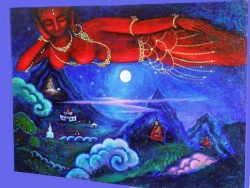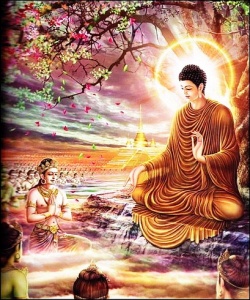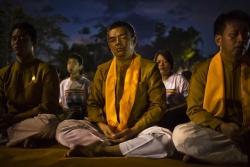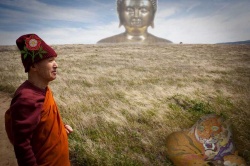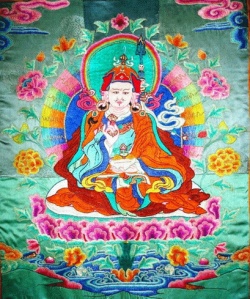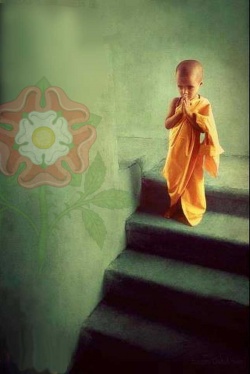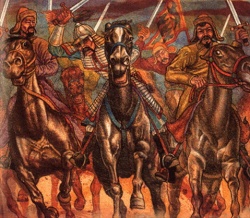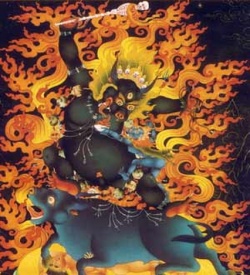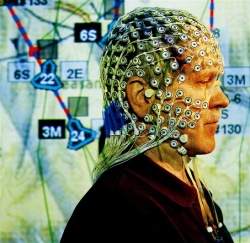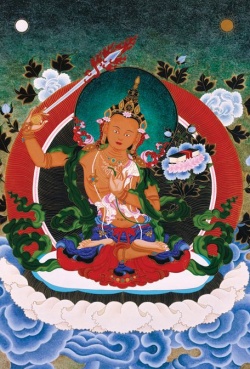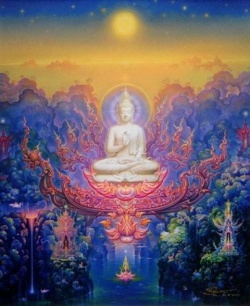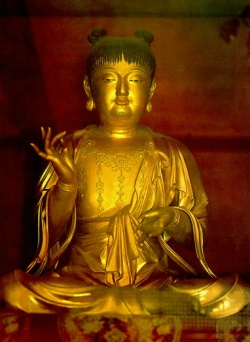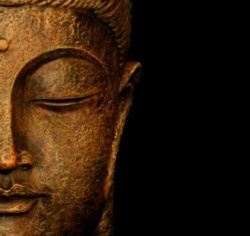Buddist Holy Wars
Introduction
This short essay is about how even within Buddhism, with its peaceful public persona, truly appaling acts of human violence can and have been justified.
I ask here whether these justifications, exemplfied by ‘Imperial Way Buddhism”, have any legitamacy or whether they are a distortion of the Buddha’s Dharma?
I also take a rather anxious look at my own ethics, asking whether my rather ad hoc and individualistic moral choices would be better if guided more narrowly by Early Buddhisms five precepts as opposed to the greater flexibility of the Mâhâyana approach.
I have recognized in Zen’s ethical position – one that here stands accused – a similarity to my own tradition of Dzogchen (rdzogs-chen).
Both, by placing a particular value on non-dual awareness as the ultimate skillful means, may be seen to be in danger of relegating the importance of a predetermined moral code to a secondary position.
Given the consequences of this during Zen’s compliance with Japanese imperialism it is worrying to think that Dzogchen may share a vulnerability to the same sort of misuse.
As we shall see, Japanese Buddhism broadly supported and legitimized, via Mâhâyana philosophy, expansionist policies that directly caused unimaginable amounts of suffering during the first half of the last century.
By extension, this essay also touches on how a Buddhist teaching can be distorted. I hope, by particularly looking here at Buddhist complicity with Japanese militarism, it may be possible to understand more clearly how Buddhadharma may be misconstrued.
Also whilst it is easy to see others as somehow uniquely bad or ignorant I suggest that no one has sole ownership of these qualities.
Under the appropriate conditions we are all capable of similar mistakes to those made by Japanese Buddhists.
Therefore finally what is important here is our own ability to use this material as a mirror for ourselves, to see how our own blindness may be tripping us up and is harming others. Speaking of Haku’un Yasutani, a Zen Roshi discredited for his war time involvement, Bodhin Kjolhed, abbot of Rochester Zen Centre, says:
The most compelling task for those of us sobered by the revelations about Yasutani Roshi is to turn our attention back to ourselves unflinchingly. What collective assumptions and mental attachments do we share that are causing us even now to corrupt the dharma? (Tricycle Fall 1999:70)
The case for the prosecution
Violence and participation in wars is not unknown in countries where people practice Buddhism.
However in Japan a militaristic culture seems to have colonized Buddhism to the extent that at times the two have become synonymous.
Brian Victoria paraphrases the commentator Ichikawa Hakugen, “. . the unity of Zen and the sword has deep roots in Zen Buddhist doctrine and history.” (Victoria 1977:xi).
He also lays the charge that by becoming aligned with the state Zen (and we could extend this to nearly all forms of Japanese Buddhism) betrayed its principles to the degree that it was no longer Buddhist.
“I will go so far as to say that institutional Zen Buddhism in Japan is not Buddhism.” (Stephens interviewing Victoria )
In the light of history it would seem there is no plea possible here except guilty, however, until recently, no acknowledgment of any guilt has been forthcoming (Jalon 2003).
Harvey (2000:264-70) gives a sobering overview. Japans extremely unstable political environment and a particularly martial mentality created expressions of Buddhism that found ways to legitimize involvement in violent conflict.
Harvey suggests that the long periods of political instability over different eras meant that warrior monks, sôhei and shuto, became the accepted means to defend monasteries which fostered strong sectarian identities (2000:264).
And that, although the Rinzai Zen school itself did not join in this directly, they too were implicated through training first bushi and then samurai in Zen and its extension into the arts of war (2000:266-7).
The shenanigans of all involved are complex but what it amounts to is conflict between different competing power bases, some religious, some secular, that builds inexorably towards an unholy marriage of Buddhism and the state.
Many instances of Buddhist justification of aggression are found in this history.
By the early twelfth century the Tendai school justified maintaining an army with an early version of the Mahâ-parinirvâ.na Sûtra which supported defensive violence (Harvey 2000:265).
This Sûtra describes the Buddha in a previous life killing several brahmins for “slandering Mahâyâna teachings.”
These brahmins are examples of a group of persons called icchântika, some one who can never awake due to their irremediable actions and who therefore the killing of causes no adverse karmic effects.
Other schools followed the Tendai, tantric Shingon, Pure Land and Nircheren schools all slaughtering each other for the true faith and in turn being slaughtered by the state when they represented a threat (Harvey 1990:168, 2000:266).
In amongst this emerges the concept of mu-shin, no-mind. Zen Buddhism’s understanding that when we act spontaneously from a state of nondual consciousness the action creates no karmic trace.
This must have been of particular importance to samurai in the uncomfortable position of being professional killers exposed to the Buddhist belief that killing leads to a lengthy sojourn in hell.
As such, mu-shin offers both the ultimate state of mind in which to kill and a means to be free of the consequences of killing.
Perhaps an archetypal example of such a samurai is the master Takuan Sôtô Zenji (1573-1645) who clearly associates such spontaneous fighting with resting in the emptiness of Original Mind (de Bary 1972:376-8).
This unholy marriage finally finds expression in ‘imperial-way Buddhism’ in the twentieth century. Victoria says of this:
Stated in Buddhist terms, imperial-way Buddhism represented the total and unequivocal subjugation of the law of the Buddha to the law of the Sovereign.
In political terms, it meant the subjugation of institutional Buddhism to the State and its policies. (1977:79)
Justification for imperial-way Buddhism is provided by two Sôtô Zen scholars, Hayashiya and Shimakage.
This is unexpected because Dôgen (1200-53), the founder of Sôtô Zen, is not initially implicated, unlike Rinzai Zen, with state authority. Paul Williams says, “Dôgen established an austere form of Zen, his monasteries deep in the mountains, and refused to compromise with secular authority’ (Williams 1989:114).
However Hayashiya and Shimakage, building upon the Mahâyâna legitimatization of killing when it is an expression of skillful means, say:
Chinese Buddhists believe that war should be absolutely avoided no matter what the reason.
Japanese Buddhists . . . believe that that war conducted for [good] reasons is in accord with the great benevolence and compassion of Buddhism. (Victoria 1977:87)
The consequences of this belief is an estimated six million people killed by Japanese armies.
The Nanking atrocities being most visible:
During the Nanking Massacre, the Japanese committed a litany of atrocities against innocent civilians, including mass execution, raping, looting, and burning. (www.cnd.org/njmassacre)
Victoria summarizes this material:
The ideas I have encountered in the subterranean realm of Buddhism were the exact inverse from those on the surface. Down below, warfare and killing were described as manifestations of Buddhist compassion.
The ‘selflessness’ of Zen meant absolute and unquestioning submission to the will and dictates of the emperor.
And the purpose of religion was to preserve the state and punish any country or person who dared interfere with its right of self-aggrandizement. (Victoria 1977:x)
Plainly there is a case to answer.
The case for the defense
Buddhist justifications for violence and war are to be found in Mâhâyana Buddhism although, unlike the early Sûtra’s and Vinaya, moral rules are not systematized but are scattered through out a number of Sûtras (Keown 1992:135).
These justifications evolve from the notions of the Bodhisattva’s compassionate aspiration to end the suffering of all sentient beings, the skillful means, upâya kau’salya, (more accurately “skill in means”),
that may be used to achieve this and in the specific Japanese context, the legitimate use of skillful aggression by a ruler charged with the responsibility of protecting his subjects and the Dharma they follow.
The idea of skillful means is found in early Buddhism.
The precepts and the rule of the Vinaya are in themselves expressions of skillful means.
Also the Buddha demonstrates in the stories of his solutions for Nandi’s erotic fantasies and Kisa Gotami’s grief that the means justify the end when done with the right motivation.
In this he prefigures the Mâhâyana idea which is developed in the Lotus Sûtra where we see skillful means not only indicates acting expediently for individuals but also teaching partial truths that are superseded as the capacity of students grows.
Finally this is extended to also mean that the precepts may be broken when the greater goal of acting compassionately is better served. A move Harvey suggests is from a virtue ethic to a situation ethic form of utilitarianism.
(Harvey BUDMOD 2, Sn.12 Introduction)
Thus in the parable of the Burning House, found in the Lotus Sûtra, skillful means is exemplified not by “particular ethical precepts but a broad orientation to teaching and actions” (Harvey BUDMOD 2, Sn.12:4 )
Or, simpler still, from the letter to the spirit of the law (Harvey 2000:149).
While Early Buddhism’s basic values are insight, paññâ, and morality, ´sîla, Mâhâyana Buddhism’s are insight , prâjna, and means, upâya, or insight and compassion, kurunâ (Keown 1992:143).
Mâhâyana Buddhism sees itself as superior in this. Morality is not only the abstemious relinquishing of grasping but also a positive means to accumulate,
keep and increase merit as well as the means to help sentient beings by taking the responsibility to benefit them. Describing this path of the Bodhisattva Keown says it is:
a new emphasis on the function of moral virtue as a dynamic other-regarding quality, rather than primarily concerned with personal development and self control. (Keown 1992:131)
Thus the Bodhisattva’s path incorporates a wide range of skillful means that include firstly practicing the first five and sixth perfections, a path that consists of skillful means and wisdom, upâya and prâjna.
Adapting the teaching to make it approachable. Manifesting as heavenly Buddhas and Bodhisattvas according to the needs of beings. And lastly,
when necessary, breaking precepts to achieve a higher good.
The Bodhisattva-bhûmi illustrates this last one, which is a significant change from the earlier strict admonishment to do no harm. It now allows:
Taking the life of someone about to commit an act entailing immediate retribution (ânantarya-karma) in order to prevent them suffering the evil consequences of that act. (Bodhisattva-bhûmi C1, Keown 1992:143)
This is an example of the taking of life when it arises from a virtuous thought.
The Upâya-kau´salya Sûtra justifies this in the story of Buddha as the Bodhisattva ‘Great Compassion’ who kills a robber and is willing to take the consequences.
Likewise in Mahâ-Upâya-kau´salya Sûtra a Bodhisattva kills a scout for bandits and in the Bodhisattva-bhûmi seeing a robber about to kill the Bodhisattva kills him.
What saves the Bodhisattvas in each of these circumstances from the karmic consequences is the good karma created by their willingness to suffer for another which cancels the bad – more or less.
Returning specifically to Japan, there are also some Sûtra’s that condone the the skillful waging of wars against others when done with the correct motivation.
The Ârya-bodhisattva-gocaropâya-vi.saya-vikurva.na-nirde’sa Sûtra offers advice to a king when commencing hostilities.
His motive must be love and compassion while seeking to protect his subjects.
This justification is exemplified in the rational given by Hayashiya and Shimakage who legitimize imperial way Buddhism with this argument.
For them the Emperor is not only the protector of the Dharma, a Cakravartin-raja, but also the secular equivalent of the Buddha.
The reason Japanese Buddhism regards the emperor as a “Golden Wheel-Turning Sacred King” is because he is the Tathâgata . . of the secular world. (Hayashiya and Shimakage in Victoria 1997:98)
Thus his edicts represented the will of the Buddha to act in a way to benefit all sentient beings.
Edicts that required the Japanese nation to make reluctant, compassionate war on Russia, China and then America and England and their allies solely to save them from themselves:
In order to establish eternal peace in East Asia, arousing the great benevolence and compassion of Buddhism, we are sometimes accepting and sometimes forceful.
We now have no choice but to exercise the benevolent forcefulness of “killing one in order that many may live” (issatsu tasho).
This is something which Mâhâyana Buddhism approves of only with the greatest of seriousness. (Hayashiya and Shimakage in Victoria 1997:87)
The Judgment
Japanese Buddhism and particularly Zen has been charged with collusion with state aggression by justifying and legitimizing it with Buddhist principles.
This lead to harming and killing many hundreds of thousands of people and also to distorting Buddhist teaching.
The prosecution has shown that all schools of Buddhism, with the possible exception of Soka Gakkai, (Harvey 2000:170, Spence BUDMOD 2, Discussions Sn.17, Victoria and Soka Gakkai, 3.12.2007) took part in this and that this collusion had its roots deep in Japanese history.
Also that the valuing of non-dualism particularly encourages immoral action by over valuing the ultimate reality of emptiness at the expense of the relative reality and the exercise of compassion.
The defense has said that the Great Vehicle supports, as an expression of compassion on a relative level, the use of skillful means that appear to contradict the precepts.
On an ultimate level there is no charge to lay because there is no criminal, no crime and no crime victim.
I believe that this defense is unconvincing.
Broadly it denies the larger Mâhâyana understanding of the path and the activities of the Bodhisattva by distorting it via the use of selective passages from a minority of Sûtra’s.
Further more, it ignores that the examples of Bodhisattva’s killing out of skillful means are to be understood symbolically (Renolds 2008),
not as a guideline for governments and the soldiers that they employ.
Such activity, were it to occur could only happen if the persons were free of defilement’s, having the perfect wisdom and compassion of a highly realized Bodhisattva (Keown 1992:151-4).
Governments and armies are unlikely to be able to claim this.
In counterpoint Mâhâyana Buddhism offers a great deal of guidance that directly contradicts the use of violence and any involvement in war mongering. This is a synopsis of my reading:
The whole thrust of the Mâhâyana is the ideal of the Bodhisattva who generates bodhicitta for the sake of all sentient beings so that our suffering may be brought to an end.
Although this sometimes may have a wrathful expression it is invariably explicitly clear that the skillful means used are doing exactly what they intend.
This is achieved via the complex path of the Bodhisattva consisting of attaining the ten stages, bhûmi, during which the ten ‘perfections’, pârâmitas, are accomplished.
Even a cursory glance at these demonstrates their incompatibility with martial aims.
Generosity, ethical conduct, patience, vigor and wisdom followed by a further four, skill in means, determination, strength and knowledge.
Practices enabling this likewise demonstrate their non-martial character.
For instance generating the four immeasurables or ‘divine abodes’, (brahma-vihâras), loving kindness, compassion, sympathetic joy and equanimity. ‘Exchanging self for other and ‘Giving and Receiving’.
Texts that describe in detail the ethics of a Bodhisattva, (eg. Bodhisattva-bhûmi, ´Sik.sâ-samuccaya), overwhelmingly support behaviours that clearly place the well being of the other first. Breaking the basic precepts does not have universal assent and when it has, it is clear that this is almost without exception the prerogative of the most highly accomplished (Gethin 1998:226-231, Harvey 2000:123-38, Keown 1992:129-64, Williams 1989:204-14).
Mitigating factors
Are there any mitigating factors then in this apparent distortion of Buddhist teaching, particularly regarding Zen?
Thomas Kirchner, an American monk who translated the recent apologies for collusion with Japanese imperialism issued by some Buddhist groups.
Masataka Toga, secretary general of Tenryu-ji.
And the prize winning author on modern Japan, Herbert Bix. While broadly in agreement, believe that Victoria, has offered an overly black and white picture which does not take sufficient account of conformist pressures (Jalon 2003).
This is echoed by Kjolhede, (Tricycle Fall 1999), who reminds us, not only of the different Japanese context, but also how the very notion of the person was different.
Kasulis (1981) describes this difference. The nature of the individual is contextual rather than individual – this means the person has no real identity unless within a social matrix.
“Without a clearly established context, people are individually distinguishable, but meaningless as persons in the full sense.” (1981:8)
What is important is not the individual but what is created between people.
A Japanese persons identity is not centered in their individuality but in their relationship to the collective order.
Thus it is almost impossible to know how to be unless one knows the context in which one is operating – is this person beneath or above me? What is our relationship and the expectations that flow from this? Strange as this is to us, we must be wary of pathologising this difference.
It is possible to think that the japanese are over identified with their public face while the individual is repressed but this fails to see that our tools of analysis are themselves a product of our own individualistic value system.
Perhaps the terms of ‘individual ego’ and ‘persona’ are meaningless here – in Japan, at this time, a person is entirely their role, this is the primary and authentic source of their self identity.
In the light of this the absence of separation between Buddhism and the State and the poor anti war protest makes much more sense. Kjolhede, speaking of Haku’un Yasutani, describes this:
Like so many other Japanese Zen men of his time and before, Yasutani-Roshi did not see himself as subordinating the Buddha-dharma to the state because he saw these as two aspects of the same truth (Tricycle Fall 1999:70).
Further more, as well as rethinking our understanding of the individual we must also rethink our understanding of Buddhist ethics. It is difficult to argue successfully for some form of essential truer Buddhism.
In fact the Buddha warns us of seeking essences and also of grasping onto views.
This reminds us not to judge Japanese expressions of Buddhism solely from the perspective of other Buddhist traditions.
If we are to make a judgment it must be on the basis of whether the form of Buddhism judged meets its own (even if shared) moral criteria – not simply the exclusive criteria of another quite different school.
In this light it is important to remember that the Pure Land schools, Shingon and Zen each have their own ethical understanding.
The two Pure Land schools, Jodo ‘Pure Land’ and Jodo-shin, the ‘True Pure Land’, share the belief that we have reached a time of such spiritual darkness that our own efforts to win salvation are ineffective.
Therefore we must place our trust in the saving grace of Amida, the Buddha of Light, to gain access to his Pure Land heaven.
However in this belief the purpose of our own ethical striving becomes uncertain, if Amida will save us what purpose does it have?
Thus a view held, if not shared by all, is “If we can not contribute to our own liberation why do anything”? (Harvey:2000:143 )
I am unsure to what degree Shingon, a Mantrayana teaching introduced to Japan by Kûkai, retained its antinomian characteristics derived from Indian yogis celebrating their taboo breaking sacred feasts, gana pujâ, in cemeteries and by burning ghats. Certainly Nichiren (1222-82) saw it as “a force that ‘ruins the country’.”
(Williams 1989:161). However it does appear that the use of mantras to effect violent change occurred in Japan.
(Harvey BUBMOD2, Sn.17:6) This certainly reflects the more permissive Mâhâyana understanding of the precepts and also expresses the Madhyamaka truth that that which obscures is itself empty of inherent existence and therefore must not be grasped onto.
Finally the Sôtô Zen of Dôgen, profoundly influenced by the notion of the Buddha nature, Tathâgata-garbha, holds that we can not create our Buddha nature because it is not part of the co-created universe of things. Rather:
For Dôgen, proper sitting authenticates the enlightenment already there.
Conversely, the student never reaches the point at which zazen is superseded.
To say that one practices zazen in order to become an enlightened person is like saying one practices medicine to become a doctor.
To practice medicine is to be a doctor.
To practice zazen is to be enlightened. (Kasulis 1981:78)
Therefore ethical action can not contribute to liberation in any way, instead, when we act ethically we are making manifest the enlightened qualities and activities of the Buddha nature as they already exist.
Ethical action arises spontaneously and displays enlightenment rather than enables it.
Judgment in response
So are these truly mitigating factors?
While Victoria may be accused of simplification, Jalon reports that there is no scholar of note anywhere that does not broadly agree with his findings (Jalon 2003).
If we are to argue that the context placed undue pressure upon a people peculiarly susceptible to responding to the collective rather than their individual conscience then we would also have to conclude that this susceptibility has been present through out the whole of Japanese history and was not an aberration of imperial way Buddhism.
Finally, while it is the case that different schools of Buddhism conceive the place of ethics differently on the path it is not true that the actions the state demanded of its soldiers have any relevant doctrinal justification and therefor their acts of aggression, violence and war are simply examples of defilement’s that create endless suffering and not a radically different expression of skillful means.
Thus, although we must take into account the special Japanese situation, judging it according to its own lights, it is also true that it failed its own Mâhâyana ideals, distorting when colluding with the state its shared ethical values with Early Buddhism and becoming a law unto itself.
The Sentence
As I said at the beginning of the essay, the most important thing here is to see if we too are making similar mistakes or are capable of making them. Returning to Haku’un Yasutani, it is interesting to see how his student, Robert Aitken Roshi, retired abbot of Hawai’i Diamond Sangha, attempts to excuse him. He says:
Unlike the other researchers, Victoria writes in a vacuum.
He extracts words and deeds of Japanese Buddhist leaders from their cultural and temporal context and judges them from a present-day, progressive, Western point of view. (Tricycle Fall 1999:67)
And though, while recognizing Yasutani’s identification with imperial way Buddhism, his explicit anti-Semitism and his continuing adherence to fascism, he also improbably says:
Perhaps someone with analytical skills could link the anger he manifested in his political and sectarian pronouncements with the fact that his mother gave him up for adoption to a Buddhist priest when he was only five years old and then he grew up to be an angry youth and adult. (Tricycle Fall 1999:68)
As one with such skills I would say it is important not to mistake a cause for an excuse.
Yasutani was entirely responsible for his actions what ever the causes and conditions that contributed to them.
Commentators on his case have highlighted the importance of not idealizing teachers because by doing so we easily negate the value of our own judgment.
They have also challenged the notion of the enlightened person preferring to see enlightenment as a continuing process of expressing enlightened activity (Kjolhede, Shainberg and Glassman, Tricycle Fall 1999:69-72).
To this I would add that it is also important to recognize in Yasutani and all those Japanese Buddhists, however inexcusable, an identical vulnerability to our own.
We all, when experiencing others as a threat create out of fear justifications that legitimize acts and attitudes that dehumanize them so to justify aggressive acts against them.
Aitken’s understandable defensiveness prevents him reaching deep enough, he is not able to simply say “Yes, my teacher messed up when scared.”, thereby demonstrating his own moral responsibility.
If he could – if we can – then I believe we are also more willing to recognize that we are also capable of exactly the same thing and are likewise entirely responsible. A sentence of personal responsibility for life.
Conclusion
I started this essay on a personal note. I spoke of my own ethical inclinations and my concerns about Dzogchen.
I also suggested that the history of Japanese Buddhism offers lessons to us in the present by acting as a warning how even the most eminent Buddhists, like Haku’un Yasutani, can lose their way.
I then used the device of a trial to argue the case that there was indeed a Buddhist justification for violence and even war.
However I concluded that the support for this was minimal and arguably was not to be taken literally. That the overwhelming weight of Buddhist teaching did not support it.
Further more mitigating factors such as the cultural context and the local variations of Buddhist ethic did not amount to any form of excuse.
A fact reflected in my sentence of personal and unremitting responsibility, for in responsibility is also freedom.
Lastly I want to note a line of inquiry that keeps creeping into this essay but which due to the already swollen word limit has been repeatedly edited out. This is the issue of mu-shin, no-mind, pre conceptual non-dual consciousness.
In my reading I have discovered its close associations with Northern Buddhism’s Mahâmudrâ and rDzogs-chen as a teaching that goes beyond cause and effect.
As such it throws up some philosophical problems about the impact of ultimate truth upon the relative that could justify actions that superficially fly in the face of conventional Buddhist ethics.
This is the world of Mahâ-siddha’s, ‘crazy wisdom’ gurus and iconoclastic Roshi’s.
All of whom challenge our understanding of skillful means by stretching it to breaking point.
Bibliography
Conze E. 1995 Buddhist Texts Through the Ages Oxford, One World
de Bary, W.T. 1972 The Buddhist Tradition in India, China and Japan, Vintage Books, New York
Gethin, R. 1998 The Foundations of Buddhism Oxford University Press
Harvey P. 1990 An Introduction To Buddhism Cambridge, Cambridge University Press
Harvey, P. 2000 An Introduction to Buddhist Ethics: Foundations, Values and Issues, Cambridge University Press
Jalon, A. M. Review Brian Victoria’s Zen War Stories
.http://www.thezensite.com February 28th. 2008 >.http://www.thezensite.com/ZenBookReviews/ZenWarStories.htm
Keown, D. 1992 The Nature of Buddhist Ethics, London, Palgrave
Kusalis, T.P. 1981 Zen Action Zen Person Honolulu, University of Hawaii Press
Loy, D. Review Brian Victoria’s Zen at War The Zen Site, .http://www.thezensite.com, Febuary 28th. 2008 > .http//ZenBookReviews/ZenAtWar_Loy.htm
McFarlane, S. 1990, ‘Mushin, Morals and Martial Arts – A Discussion of Keenan’s Yogâcâra Critique’ in Japanese Journal of Religious Studies, Vol.17 no.4 397-420
J.P. Keenan, ‘The Mystique of Martial Arts: A Response to Professor McFarlane’ in Japanese Journal of Religious Studies, Vol.17 no.4 421-432
Nanking Massacre http://www.cnd.org, Febuary 28th. 2008 >http://www.cnd.org/njmassacre/nj.html#NJMl
Norbu, N. 2007 Private Notes, Barcelona Retreat
Renolds, J. 2008 Private Correspondence
Stephens, C. Interview with Brian Victoria
Tatz. M. 1994 The Skill in Means Sûtra, Delhi, Motilal Banarsidas
http://www.japanfile.com February 28th. 2008 >http://www.japanfile.com/culture_and_society/religion/zenholywar.shtml
Victoria, B. 1997, Zen at War, New York and Tokyo, Weatherhill
Victoria, B., Aitkin, R., Glassman, B., Kjolhede, B., Shainberg, L., 1999 ‘Yosutani Roshi: The Hardest Koan’ in Tricycle Vol: ix no.1 60-76
Walshe, M. 1987 The Long Discourses of the Buddha, Wisdom Publications, Boston
Williams, Paul and Tribe, Antony 2000 Buddhist Thought- A complete introduction to the Indian Traditions Routledge, London and New York

